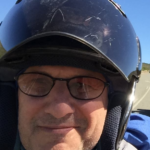 by Peter Francis Deck
by Peter Francis Deck
Srebrenica massacre
History is how you remember it.
A day that repeats in my mind while in Bosnia was the day of the Srebrenica massacre that began 11 July 1995. Over 8,300 men and boys were killed by the Bosnian Serb and Serb forces that took place over some days. I just arrived back in Sarajevo after working some months in Mostar. There were few international staff in the Sarajevo office, only the radio operator, the public information officer, and me, the “protection officer”. There had been significant shelling of the City and all international staff was evacuated and recently some allowed to return.
It was a hot and quiet day in Sarajevo. I was in the air-conditioned radio room typing on a radio message sending machine we called a “pactor” to the UNHCR officer Andre Kazakov who was covering Srebrenica from Belgrade. Staff based in Bosnia were not given permission to enter Srebrenica or any of the enclaves that the Serbs controlled in Eastern Bosnia at that time. With Kozakov’s Russian nationality, he was given permission to travel to many locations that non-Serb aligned nationalities were denied to go. As women and children were expelled and who then fled through the forests to Tuzla, a Bosnian government-controlled City, news started to trickle out of how the Serb forces entered Srebrenica and separated all men from women.
From UNHCR’s side, prior to the taking of the town, there was concern that the Serbs had seized a humanitarian aid convoy loaded with mainly food and fuel for generators for medical supplies and equipment. Kazakov had gone as an escort for the convoy to ensure the passage of the humanitarian assistance that was previously approved by the Bosnian Serb authorities to enter Srebrenica. Kazakov reported that the Serbs wanted to take control of the trucks. There was some confusion about what does that means? Do they want to trucks or the goods on the trucks? After some time he reported that after negotiation the commander in charge agreed not to take the humanitarian assistance on the trucks or the trucks but took all the fuel on the trucks and drained the fuel tanks to use the trucks’ diesel. From what I remember, Kazakov reported this as a positive negotiated conclusion and informed Sarajevo that he requested fuel to be sent from Serbia so the convoy trucks could then make the trip back to Belgrade. He said that he would stand by until the new convoy with additional fuel arrived so would have to spend the night in Srebrenica. A few hours passed and more unconfirmed stories including men being killed were coming in from different news and UN sources. These reports were from interviews of traumatized family members who were forced to flee Srebrenica.
I asked the radio operator if I could directly type a message to Kozokov. I could not directly say are people being killed, but I made a clear statement requesting him to describe the situation. The response was, “all normal and quiet.”
Days later we had learned what had exactly happened. The UNHCR fuel was taken to be used in local trucks that took the men and some boys into the woods where they were killed and buried. From questions over months about UNHCR knowledge and involvement, from my understanding backhoes were also fueled for the digging of mass graves. The Public Information officer Kris Janowski and I kept trying to get more information from Kozokov on exactly what he saw. He said he saw nothing that indicated something wrong was happening. When I met with Kozokov a few weeks later at a UNHCR regional meeting, after the facts were publicly out about the massacre, he repeated he did not see anything when he was there.
The Dutch UN forces that were present did not prevent the Serbs from entering or the massacre. Recently, in 2019 the Dutch supreme court ruled that the State was liable for preventing the deaths but used a legal calculation that concluded the State was responsible for only about 10% of the deaths. UNHCR and the use of its fuel were never mentioned in any report that I have read. I had printed out a copy of the “pactor” communication with Kazakov and had kept that with me for many years but going through my papers now I cannot find it. Kozokov now has a high-level Director position in UNHCR. I never could look at him without thinking he saw more in Srebrenica.

